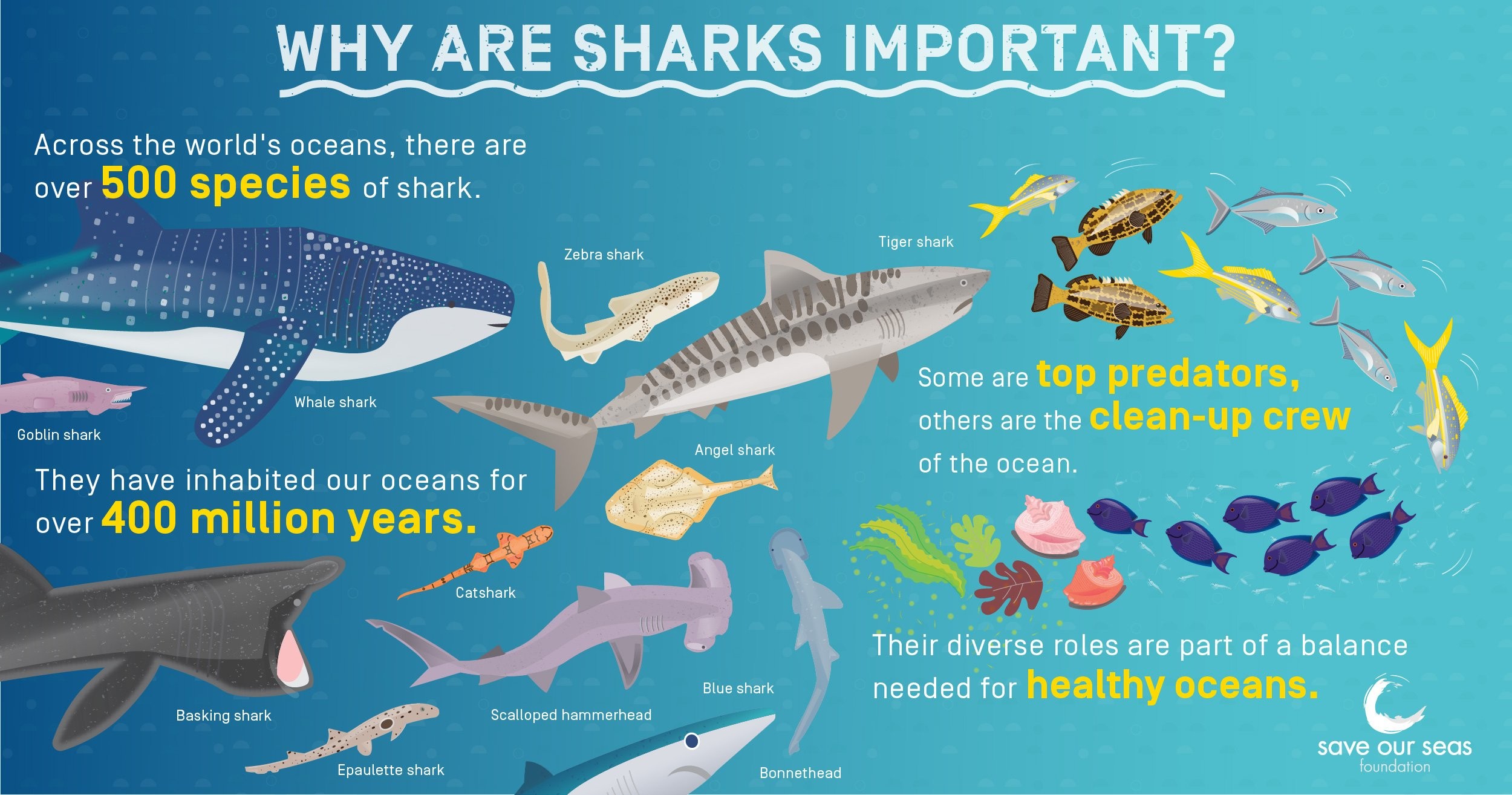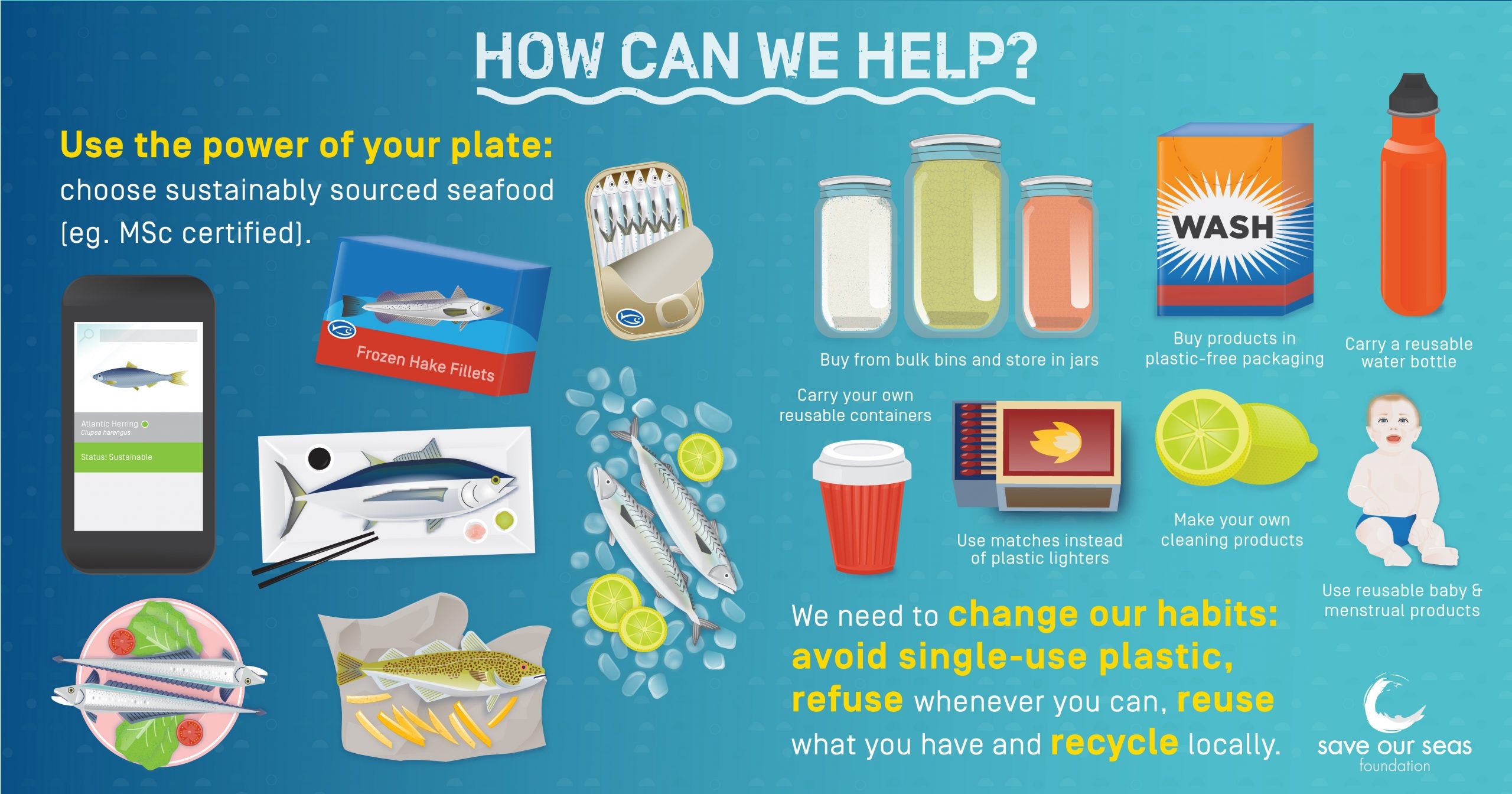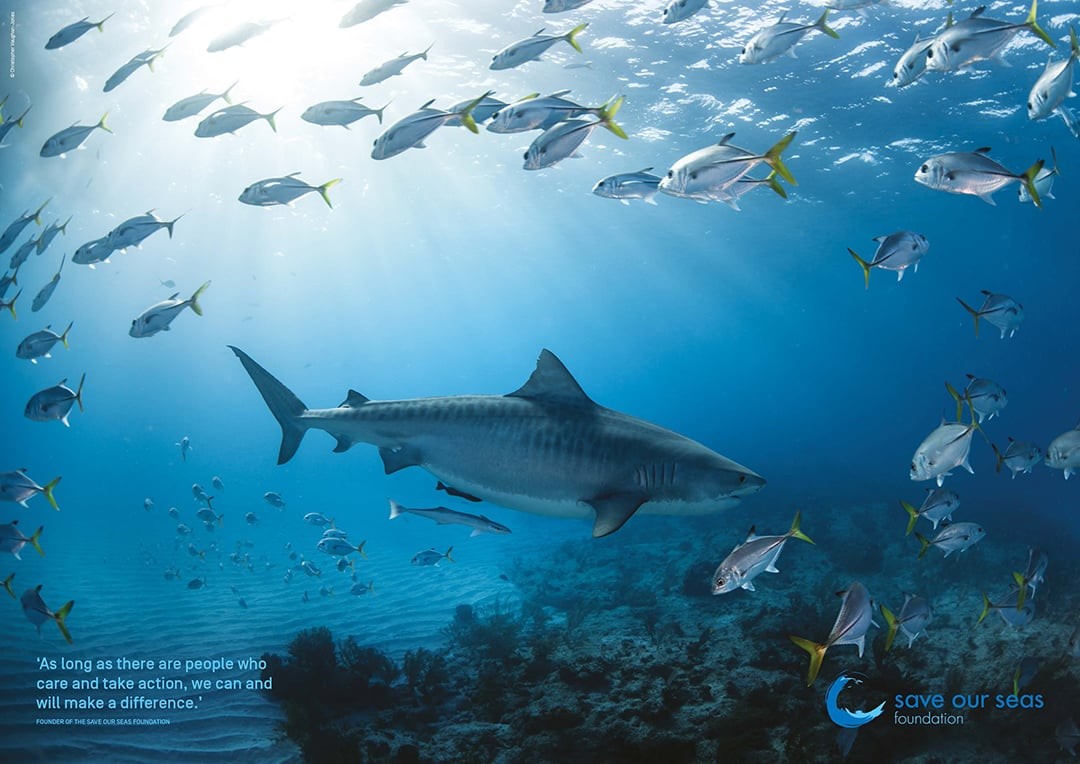Why Are Sharks Important? Sharks, apex predators of the ocean, play a crucial role in maintaining the health and balance of marine ecosystems, influencing everything from prey populations to nutrient cycling. At WHY.EDU.VN, we delve into the fascinating world of sharks to understand their ecological significance and the urgent need for their conservation, shedding light on the importance of shark conservation and the benefits of healthy shark populations. Explore shark facts, shark research and marine conservation efforts.
1. Understanding the Ecological Importance of Sharks
Sharks are often misunderstood and feared, but their role in the ocean’s ecosystem is undeniably vital. Their presence or absence can significantly impact the entire marine environment.
1.1. Sharks as Apex Predators: Regulating the Food Web
As apex predators, sharks sit at the top of the food chain. They regulate populations of their prey, preventing any single species from becoming dominant and disrupting the balance of the ecosystem. According to a study published in Science, the removal of apex predators can lead to trophic cascades, where the effects ripple down through the food web, causing imbalances and even ecosystem collapse.
1.2. Maintaining Biodiversity and Ecosystem Health
Sharks help maintain biodiversity by preying on the sick, weak, and injured animals, preventing the spread of disease and ensuring that only the fittest survive and reproduce. This natural selection process strengthens the gene pool and promotes healthy populations of prey species. A report by the International Union for Conservation of Nature (IUCN) highlights that the decline of shark populations can lead to a decrease in biodiversity and overall ecosystem health.
1.3. Controlling Invasive Species
Sharks can also play a role in controlling invasive species. By preying on non-native species, they help prevent these species from becoming established and outcompeting native species, thus protecting the integrity of the ecosystem.
1.4. Sharks’ Impact on Seagrass and Coral Reef Ecosystems
The presence of sharks can have a positive impact on seagrass beds and coral reefs. For example, tiger sharks prevent green turtles from overgrazing seagrass beds, which is critical for the health and function of these ecosystems as carbon sinks. Similarly, sharks help maintain the health of coral reefs by preying on herbivorous fish that can overgraze algae, preventing the algae from smothering the coral.
2. The Economic Value of Sharks
Beyond their ecological importance, sharks also have economic value. This value is often overlooked, but it is becoming increasingly recognized as shark populations decline.
2.1. Shark Tourism and Diving
Shark tourism, particularly shark diving, has become a popular activity in many parts of the world. Divers are willing to pay significant amounts of money to see sharks in their natural habitat, generating revenue for local communities. A study by the Pew Charitable Trusts found that shark tourism can generate millions of dollars annually, often exceeding the value of shark fishing.
2.2. Sustainable Fisheries Management
Sustainable fisheries management of shark populations can also provide economic benefits. By managing shark fisheries responsibly, it is possible to harvest sharks without depleting their populations, ensuring that this resource is available for future generations.
2.3. The Potential Loss of Revenue Due to Shark Depletion
The loss of shark populations can have significant economic consequences. The decline of shark populations can lead to a decrease in tourism revenue, as well as the loss of potential revenue from sustainable fisheries.
3. Threats to Shark Populations: A Global Crisis
Despite their importance, shark populations are facing a global crisis. Overfishing, habitat destruction, and climate change are all contributing to the decline of shark populations around the world.
3.1. Overfishing and Bycatch
Overfishing is one of the biggest threats to shark populations. Sharks are often targeted for their fins, meat, and liver oil, which are used in various products. In addition, many sharks are caught as bycatch in fisheries targeting other species. According to the Food and Agriculture Organization of the United Nations (FAO), over 100 million sharks are killed each year due to fishing.
3.2. Habitat Destruction and Degradation
Habitat destruction and degradation also pose a significant threat to shark populations. Coastal development, pollution, and destructive fishing practices can all damage or destroy critical shark habitats, such as mangrove forests and coral reefs.
3.3. Climate Change and Ocean Acidification
Climate change is another major threat to shark populations. Rising ocean temperatures, ocean acidification, and changes in ocean currents can all affect shark distribution, behavior, and reproduction.
3.4. The Impact of Shark Finning
Shark finning, the practice of removing a shark’s fins and discarding the body at sea, is a particularly cruel and wasteful practice that is driving many shark populations to the brink of extinction. The fins are used in shark fin soup, a delicacy in some cultures, while the body is often discarded because it is less valuable.
4. Conservation Efforts: Protecting Sharks for the Future
Fortunately, there are many efforts underway to protect shark populations and ensure their survival for future generations. These efforts range from international agreements to local community initiatives.
4.1. International Agreements and Regulations
Several international agreements and regulations aim to protect shark populations. The Convention on International Trade in Endangered Species (CITES) regulates the trade of certain shark species, while the Convention on Migratory Species (CMS) promotes the conservation of migratory sharks.
4.2. Marine Protected Areas and Shark Sanctuaries
Marine protected areas (MPAs) and shark sanctuaries can provide safe havens for sharks, protecting them from fishing and other threats. These areas can also serve as important breeding and nursery grounds for sharks.
4.3. Sustainable Fishing Practices and Gear Modifications
Sustainable fishing practices, such as catch limits, gear modifications to reduce bycatch, and the promotion of alternative livelihoods for fishermen, can help reduce the impact of fishing on shark populations.
4.4. Education and Awareness Campaigns
Education and awareness campaigns are crucial for changing public perceptions of sharks and promoting their conservation. By educating people about the importance of sharks and the threats they face, it is possible to garner support for conservation efforts.
5. Sharks and Human Interaction: A Delicate Balance
The relationship between humans and sharks is complex and often fraught with fear and misunderstanding. However, it is important to recognize that sharks are not mindless killers, but rather intelligent and fascinating creatures that play a vital role in the ocean’s ecosystem.
5.1. Understanding Shark Behavior and Reducing Human-Shark Conflict
Understanding shark behavior is crucial for reducing human-shark conflict. By learning about shark feeding habits, migration patterns, and social behavior, it is possible to minimize the risk of encounters and promote coexistence.
5.2. Debunking Myths and Misconceptions About Sharks
Many myths and misconceptions about sharks contribute to their negative image. It is important to debunk these myths and provide accurate information about sharks to promote a more balanced and informed perspective.
5.3. Promoting Responsible Tourism and Diving Practices
Responsible tourism and diving practices can minimize the impact of human activities on shark populations. This includes choosing reputable and responsible tour operators, avoiding feeding or disturbing sharks, and respecting their natural habitat.
6. The Role of Sharks in Nutrient Cycling
Beyond their role as predators, sharks also contribute to nutrient cycling in the ocean. This often-overlooked aspect of their importance highlights their far-reaching influence on marine ecosystems.
6.1. Sharks as Mobile Linkages Between Ecosystems
Sharks act as mobile linkages, transporting nutrients between different locations and depths. Through their migrations and diving behavior, they help distribute nutrients from nutrient-rich areas to nutrient-poor areas, and from the deep ocean to the surface waters.
6.2. The Impact of Shark Excretion on Nutrient Availability
Shark excretion also contributes to nutrient availability. Shark waste products contain essential nutrients, such as nitrogen and phosphorus, which are vital for the growth of phytoplankton and other marine organisms.
6.3. Sharks and the Biological Pump
Sharks play a role in the biological pump, the process by which carbon dioxide is transferred from the atmosphere to the deep ocean. By preying on large fish and marine mammals, sharks help ensure that these animals sink to the bottom of the ocean when they die, effectively sequestering carbon dioxide for long periods of time.
7. The Importance of Shark Research and Monitoring
To effectively protect shark populations, it is essential to conduct research and monitoring to understand their distribution, abundance, behavior, and threats.
7.1. Tracking Shark Movements and Migration Patterns
Tracking shark movements and migration patterns can help identify critical habitats and migration routes, allowing for the implementation of targeted conservation measures.
7.2. Assessing Shark Population Sizes and Trends
Assessing shark population sizes and trends is essential for determining the effectiveness of conservation efforts and identifying populations that are in need of urgent protection.
7.3. Studying Shark Behavior and Ecology
Studying shark behavior and ecology can provide valuable insights into their role in the ecosystem and the factors that influence their survival.
8. Case Studies: Successful Shark Conservation Initiatives
Several successful shark conservation initiatives demonstrate that it is possible to protect shark populations and promote their recovery.
8.1. The Galapagos Marine Reserve: A Shark Sanctuary
The Galapagos Marine Reserve is a prime example of a successful shark sanctuary. Fishing is prohibited in large areas of the reserve, providing a safe haven for sharks and other marine life.
8.2. Palau’s Shark Sanctuary: A Model for Conservation
Palau’s shark sanctuary, the first of its kind, has served as a model for other countries looking to protect their shark populations. The sanctuary prohibits all shark fishing within Palau’sExclusive Economic Zone (EEZ).
8.3. Community-Based Conservation in Fiji
Community-based conservation initiatives in Fiji have empowered local communities to protect their shark populations and manage their marine resources sustainably.
9. What You Can Do to Help Sharks
There are many things that individuals can do to help protect shark populations. Every action, no matter how small, can make a difference.
9.1. Supporting Sustainable Seafood Choices
Choosing sustainable seafood options can help reduce the demand for shark products and promote responsible fishing practices.
9.2. Reducing Plastic Consumption and Pollution
Reducing plastic consumption and pollution can help protect shark habitats and prevent sharks from ingesting harmful plastics.
9.3. Supporting Shark Conservation Organizations
Supporting shark conservation organizations can provide them with the resources they need to conduct research, implement conservation measures, and educate the public.
9.4. Spreading Awareness and Educating Others
Spreading awareness and educating others about the importance of sharks and the threats they face can help change public perceptions and promote conservation efforts.
10. The Future of Sharks: A Call to Action
The future of sharks depends on our actions today. By taking steps to protect shark populations and their habitats, we can ensure that these magnificent creatures continue to play their vital role in the ocean’s ecosystem for generations to come.
10.1. The Need for Continued Conservation Efforts
Continued conservation efforts are essential for protecting shark populations and promoting their recovery. This includes strengthening international agreements, establishing more marine protected areas, and promoting sustainable fishing practices.
10.2. The Importance of Collaboration and Partnerships
Collaboration and partnerships between governments, scientists, conservation organizations, and local communities are crucial for achieving effective shark conservation.
10.3. A Vision for a Healthy Ocean with Thriving Shark Populations
By working together, we can create a vision for a healthy ocean with thriving shark populations, where these apex predators continue to play their vital role in maintaining the balance and biodiversity of marine ecosystems.
FAQ: Common Questions About Shark Importance
Here are some frequently asked questions about the importance of sharks and their conservation.
| Question | Answer |
|---|---|
| How many types of sharks are there? | There are approximately 520 species of shark described by scientists. |
| How many shark species are endangered? | A quarter of the world’s shark species (130/520) are threatened with extinction according to the IUCN red list of threatened species. |
| Do sharks have predators? | Yes, very few shark species are free of predation, and many of them fall prey to bigger fish or marine mammals. |
| How many sharks are killed by humans each year? | It has been estimated that over 100 million sharks are killed each year by fisheries alone. |
| What is the biggest shark? | The whale shark is the world’s largest fish, measuring up to 14 m (45 ft). |
| How long have sharks existed? | Sharks in some form have been around for over 400 million years. |
| What is an elasmobranch? | Elasmobranches are a group of fishes consisting of sharks, skates, and rays. |
| What does shark skin feel like? | Shark skin is made up of tiny teeth-like structures called placoid scales, giving them a sandpaper-like texture. |
| Do sharks ever sleep? | They do not sleep like humans do and rather have restful and active periods, dependent on the species. |
| What can I do to help sharks? | Avoid unsustainable shark products, choose reputable eco-tour operators, be smart about seafood, keep shores clean, share knowledge, and support campaigns. |




Do you have more questions about the vital role of sharks in our ecosystems? Don’t hesitate to ask! At WHY.EDU.VN, we are dedicated to providing you with accurate and comprehensive answers to all your burning questions. Our team of experts is ready to delve into any topic, no matter how complex. Visit WHY.EDU.VN today at 101 Curiosity Lane, Answer Town, CA 90210, United States, or reach out via WhatsApp at +1 (213) 555-0101, and let us help you uncover the knowledge you seek. Start your journey of discovery with why.edu.vn now!